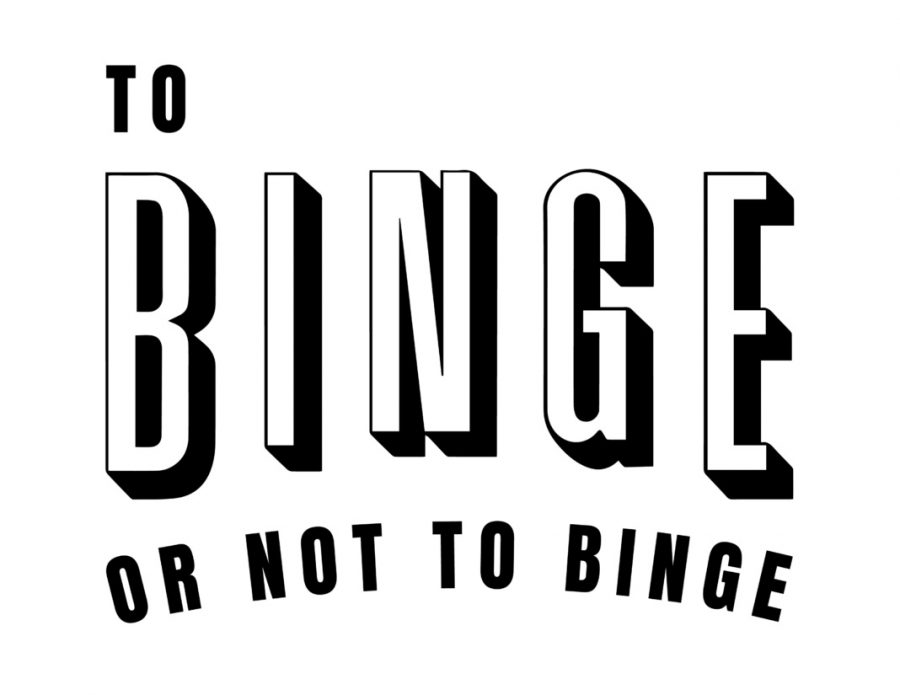To Binge or Not to Binge Episode 70: ‘Maniac’
(Graphic by Hannah Allred | The Daily Utah Chronicle)
February 26, 2020
It’s been well over a year since I first binge-watched “Maniac,” but I still think about it several times a week. The 10-part Netflix original series directed by Cary Joji Fukunaga, starring Emma Stone (as Annie Landsberg) and Jonah Hill (as Owen Milgrim) is easily one of my all-time favorites. Dazzling, raw and one of a kind, “Maniac” will lead you to the cosmos and to the depths of your own psyche, and then it will make you wonder if there’s even any difference between the two.
As I’ve learned during my year of telling people — or rather screaming at them — about this show, it’s actually pretty difficult to describe. Essentially, two maladjusted individuals living in an ’80s-esque futuristic city volunteer for the pharmaceutical trial of a drug that’s touted to cure all mental illness — no therapy needed. Needless to say, chaos ensues.
To Binge or Not to Binge?
A common critique of the show is that the first few episodes are too slow or too difficult to really get into. I can see where these viewers are coming from as it is pretty heavy on the exposition — but with a bit of patience, you will be immersed into a psychedelic media experience like none you’ve ever had before and binging will be more of a need than a question. Boasting a stunning score and top-tier performances, this dark comedy-drama is worth a watch for anyone intrigued by psychology or the space-time continuum alike.
Maybe I should start by acknowledging that I would die for Stone, so yes, it is entirely possible that I could be a bit biased here. But seriously, Stone’s hard, detached heroine is someone you just can’t look away from throughout the entire show. Stone is magnetic. Hers is a journey of learning to trust and learning to actually want to heal.
Meanwhile, Hill is not the male protagonist we’re accustomed to seeing on screen. Our hero should be strong-willed and bigger-than-life, but he’s awkward and gullible, and he struggles to decipher what’s real from what isn’t. Hill and Stone’s respective acting abilities paired with the writing of their characters make for poignant depictions of what mental illness looks like in the modern era.
Masterful acting and screenwriting aside, the visual experience of the show is reason enough to watch. A simple but satisfying color palette, smooth cinematography, insane set designs and an overall minimalist composition make “Maniac” so much fun. Even as we watch Hill and Stone undergo dramatic transformations — including but not limited to a tatted mafia boss, a woodland elf and a middle-class mom — and we enter into a new genre with practically every episode, it all feels real. This bizarrely, rapidly shifting genre and production design is the mechanism by which “Maniac” tells the story of two people thrown into an exploration of their own brains.
The setting isn’t, as is the case with many shows or films, a mere backdrop, but instead it is a fluid experience that constructs the narrative in ways that dialogue or action cannot. The setting pushes the story forward. Viewers are guided through wild and imaginative worlds such as a modern CIA headquarters under attack, a medieval fantasy kingdom and a simple 1990s American suburb. Before we know it, we are stepping into the worlds of our protagonists — two people who, like the show itself, do not fit into any comfortable category. They are unsure about where they stand — and so are we. It is a show about liminality and connectedness.
Each time and place that the characters find themselves in feels like a projection of their own subconscious and yet, it feels undeniably real. Their outer worlds are just as bright, chaotic and real as their inner worlds are, and this is the message of the series.
As Dr. Mantleray (Justin Theroux) explains in the introduction to the very first episode, “Hypothesis: All souls are on a quest to connect. Corollary: Our minds have no awareness of this quest. Hypothesis: All the worlds that almost were matter just as much as the world we’re in.”
I think the most meaningful art, the kind that stays with you, is something that transports you to a new world while simultaneously connecting with you on an intimate level to your own world. This is what great cinema does, and “Maniac” does it wonderfully. I know it doesn’t appeal to everyone the way it does to me, but there’s a really special story being told here — one that challenges popular narratives regarding gender and mental health.
Best Episode
My particular favorite is number four, “Furs by Sebastian.” You’re lying to yourself if you think you don’t want to see Stone play a poofy-haired nurse on a quest to rescue an endangered lemur.
Similar Shows
“Russian Doll,” “The End of the F***ing World” and “The Alienist”
Trigger Warnings
This show portrays grief, addiction, depression, suicide and schizophrenia. “Maniac” handles these topics thoughtfully, and ultimately, optimistically, but it does make for heavy viewing at times. Otherwise, there is moderate violence, language and sexual content.
“Maniac”
5/5 Stars
Available to stream on Netflix
Ten episodes, around 40 minutes each.












